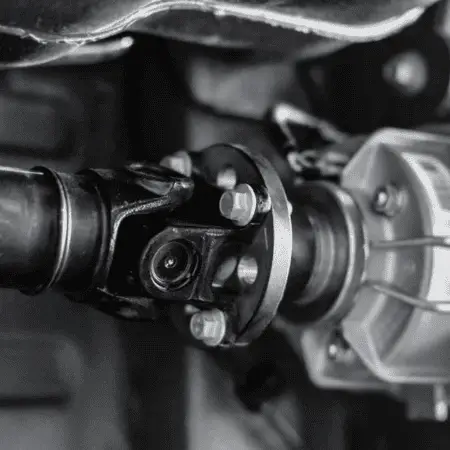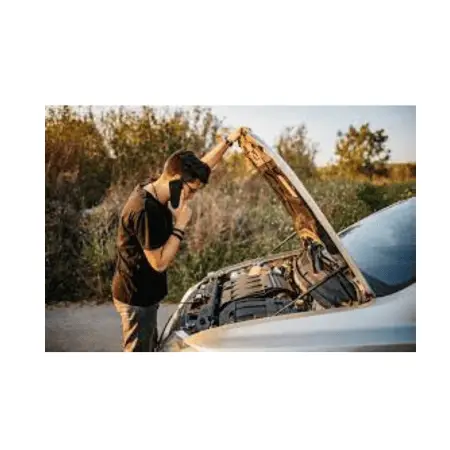Driving down the road, enjoying the breeze, your favorite tunes playing, when suddenly, there’s a loud clunk, followed by a strange vibration under your feet. Could it be your drive shaft?
You stopped the vehicle and looked around to find what may be wrong and clues about many things. And then you realize it is the drive shaft that is broken.
In this article, I will discuss, what happens if your drive shaft breaks while driving. So keep on reading to find out the best solutions to this problem.
If your drive shaft breaks while you’re driving, it’s a big problem. The drive shaft is what helps your car move forward by connecting the engine to the wheels. When it breaks, you’ll feel a sudden loss of power, strange noises, and vibrations in your car. It can be scary and make it harder to control your vehicle. Plus, other parts of your car might get damaged too. It’s important to stay safe, pull over, and get help as soon as possible.
Must Read: Drive Start Control Malfunction – Signs & Causes

You May Find Helpful
- Can You Drive Without a Muffler? Pros & Cons Of Removing Mufflers
- Is It Safe To Drive Without Power Steering?
- What Should Wheel Bearing Seals Be Checked For?
what happens if my drive shaft breaks while driving
The drive shaft is a crucial component in a vehicle that helps transfer power from the engine to the wheels. If the drive shaft breaks while driving, several things can happen, and they’re not good.
1- Loss of Power to Wheels:
The primary job of the drive shaft is to transmit power from the engine to the wheels. If it breaks, this connection is lost, and the wheels won’t receive the necessary power. As a result, the vehicle will likely come to a sudden stop.
When the drive shaft breaks, this critical link between the engine and the wheels is severed. The consequences are profound. The engine, which is still running and generating power, cannot effectively transfer that power to the wheels.
2- Difficulty Controlling the Vehicle:
When the drive shaft breaks, it disrupts this balance and can significantly affect the vehicle’s handling characteristics. One of the immediate consequences is the difficulty in steering. The steering system relies on a harmonious interaction between various components, including the drive shaft.
Without the drive shaft, the wheels may not respond as expected to steering inputs. This can make it challenging for the driver to maintain the intended direction of the vehicle. The loss of connection between the transmission and the wheels means that the wheels are no longer synchronized with the driver’s attempts to steer.
When you turn or try to navigate through traffic, suddenly the steering feels unresponsive or erratic. You may find it difficult to keep the vehicle on a straight path or execute precise maneuvers.
3- Strange Noises and Vibrations:
A broken drive shaft can cause unusual noises and vibrations. You might hear loud clunking or banging sounds from underneath the vehicle. Vibrations can be felt throughout the car, especially if the breakage is severe.
In some cases, you might hear metallic grinding or scraping noises. This indicates that the broken sections of the drive shaft are making contact with other metal components as the vehicle is in motion. The friction generated by this contact produces these distinct and often unsettling sounds.
4- Potential Damage to Other Parts:
The sudden failure of a drive shaft can cause damage to other nearby components. For example, it may damage the transmission, differential, or even the undercarriage of the vehicle.
The drive shaft is closely linked to the transmission system, responsible for regulating the power generated by the engine. When the drive shaft fails, the transmission can experience stress and strain, potentially leading to damage.
The abrupt cessation of power transmission may cause internal components within the transmission to endure forces they aren’t designed to handle, resulting in malfunctions or even complete failure.
The jarring impact of a broken drive shaft can potentially cause fluid leaks. This can include transmission fluid, differential fluid, or even engine oil leaks, depending on the specific circumstances. Fluid leaks not only contribute to potential damage but also pose environmental concerns.
5- Risk of Accident:
If the drive shaft breaks while driving at high speeds, there is a significant risk of an accident. The sudden loss of power and control can lead to a loss of balance, potentially causing the vehicle to swerve or spin out of control.
The sudden loss of power and control due to a broken drive shaft can result in unpredictable vehicle behavior. The driver may struggle to maintain a straight trajectory, and the vehicle may veer unexpectedly. This unpredictability can create a hazardous situation, especially when surrounded by other vehicles on the road.
6- Inability to Move:
In most cases, when the drive shaft breaks, the vehicle will not be able to move under its power. This can be a major inconvenience, especially if it happens in the middle of traffic or in an unsafe location.
The drive shaft serves as the vital link between the engine and the wheels, enabling the transfer of power that propels the vehicle forward. When the drive shaft breaks, this connection is abruptly severed. As a consequence, the wheels are deprived of the force necessary to turn and move the vehicle.

What to Do If the Drive Shaft Breaks While Driving
Stay Calm: It’s normal to feel a bit shaken when something goes wrong with your car. Take a moment to breathe. Panicking won’t change the situation, but a clear head will help you handle things better.
Pull Over Safely: When you notice something is off, your immediate goal is to get your vehicle to a safe spot. If you’re on a busy road, try to find a wide shoulder or an exit ramp.
Use your turn signal to let other drivers know you’re moving over, and turn on your hazard lights to make your vehicle more visible. If you’re on a narrow road without a shoulder, try to find the nearest safe turnout or parking lot.
Assess the Situation: Once you’re safely parked, it’s time to play detective. Stay inside your vehicle if you’re on a busy road, and carefully check for any visible damage.
Look under your car to see if you can spot the broken drive shaft or any loose parts.
Keep an eye out for leaking fluids as well; a damaged drive shaft might have caused other issues. If you’re not sure what you’re looking for, it’s okay – just note any observations for when help arrives.
Call for Help: If you have a roadside assistance service, this is the time to use it. Call the number provided on your membership card or app. They’re equipped to handle a range of issues, and they’ll dispatch help to your location.
Don’t Attempt to Drive: Moving the car with a broken drive shaft can cause additional harm to your vehicle. The drive shaft is crucial for transmitting power, and attempting to drive without it could lead to more extensive and costly repairs.
Secure Your Vehicle: If you have them in your car emergency kit, place warning triangles or use flares to create a visible perimeter around your vehicle. This alerts other drivers to your situation and helps prevent accidents.
Place them a good distance behind and in front of your car, especially if you’re on a curve or hill.
Check for Leaks: A broken drive shaft can sometimes cause collateral damage, especially to the transmission system. Check under your vehicle for any signs of leaking fluid, particularly transmission fluid.
It usually has a reddish color. If you notice a puddle or a trail of fluid, it’s essential to keep a safe distance. Transmission issues can be complex, and attempting to drive with low or no transmission fluid can lead to severe damage.
Tow Truck: If you don’t have roadside assistance, or if they can’t assist, call a tow truck. They specialize in transporting vehicles and will take your car to a repair shop or your preferred location.
Further Readings
- How To Clear Service Suspension System? Explained
- How To Start A Car With A Bad Crankshaft Sensor?
- Will Vinegar Damage Car Paint? Potential Risks Of Using Vinegar
Conclusion
What Happens If My Drive Shaft Breaks While Driving? Experiencing a drive shaft break while driving can be a nerve-wracking and potentially dangerous situation. Not only does it leave your vehicle immobilized, but it also poses risks to your safety and that of others on the road. However, staying calm, safely maneuvering your car off the road, and promptly seeking assistance can help mitigate the impact of such an incident.
